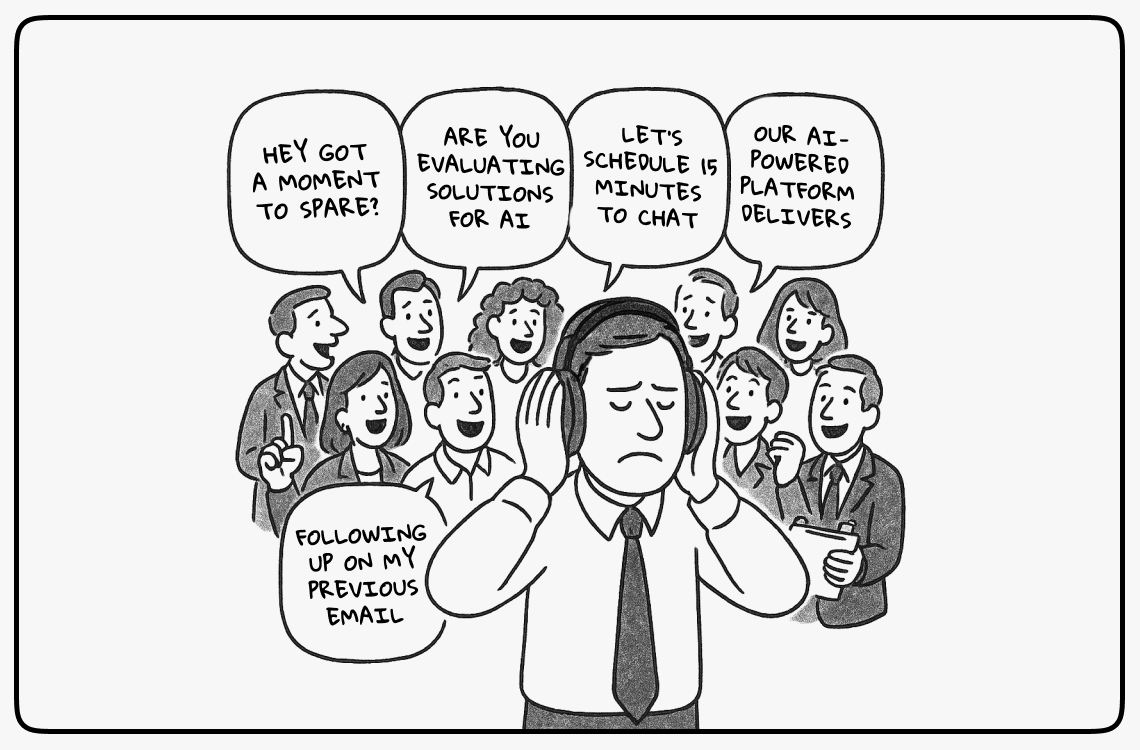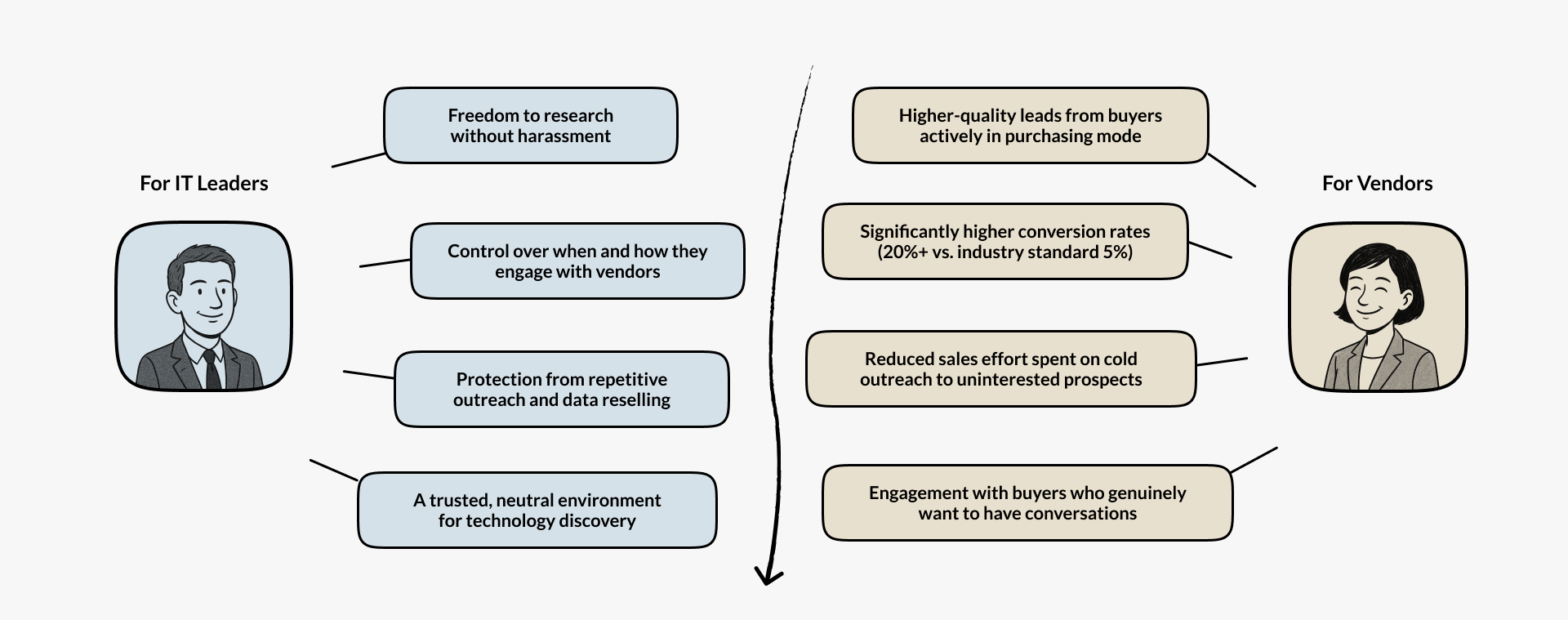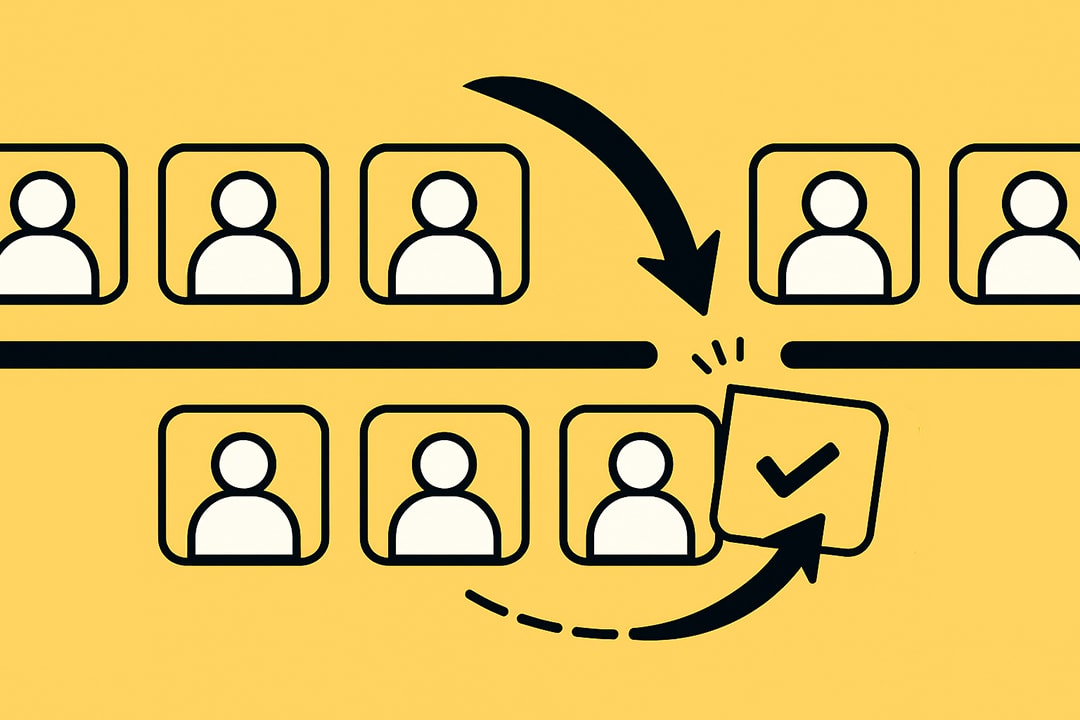How TechnologyMatch positions you differently
Why chase leads when real demand already exists? Learn how TechnologyMatch connects IT vendors with buyers who are ready to buy—no more noise, just real results.

The old playbook is broken
The classic lead gen approach—buy a list, blast cold emails, hammer the phones—has become a losing game. For years, IT vendors have relied on sheer volume, hoping that enough outreach will fill the pipeline. But today’s buyers are overwhelmed and unimpressed.
Their inboxes are flooded with generic “touches” and their phones ring with pitches that sound just like the last ten they heard.
The data is grim. Cold email response rates in B2B tech are stuck around 1–2 percent. Trade show leads rarely convert past a first call. Most “qualified” leads evaporate before a real conversation happens.
The result? Sales teams run in circles, marketing points to vanity metrics, and leadership wonders why the pipeline never translates to closed deals.
This isn’t just inefficient, it’s counterproductive. Buyers tune out, teams burn out, and trust erodes on both sides of the table.
Yet many vendors cling to these old habits, convinced that more activity will eventually deliver results. The truth: in a saturated market, making more noise only ensures you get ignored. It’s time to admit the old playbook no longer works.
Why seller-first lead gen fails
Seller-driven lead generation is built on a flawed assumption: if you push hard enough, buyers will bite. The reality is, most buyers see right through this approach.
Their daily experience is a barrage of one-sided pitches, irrelevant offers, and transactional outreach that treats them as a number, not a decision-maker.
When the process is all about filling your pipeline and hitting your quota, the buyer’s needs get lost. You chase meetings, not solutions. This creates tension—buyers become defensive, meetings become less productive, and the distance between interest and intent widens.

The problem isn’t just buyer fatigue; it’s vendor invisibility. In a market where everyone’s shouting, nobody gets heard. Decision-makers are more likely to hit delete or ignore than engage with yet another unsolicited offer. Seller-first tactics drive response rates down and increase skepticism with every generic touch.
The result? More effort, fewer results. Sales cycles drag on, conversion rates plummet, and your brand becomes just another face in the crowd. When lead generation serves only the seller, it fails everyone involved, especially in today’s IT market.
What if you started with the buyer?
Imagine a world where lead generation doesn’t start with your sales targets, but with what the buyer actually needs. Instead of fighting for attention, you earn it by listening first. You don’t pitch blindly, you uncover what’s driving the buyer’s priorities, the pain they’re desperate to solve, and the outcomes they need to deliver.
This approach flips the dynamic. The buyer isn’t running from your pitch, they’re engaged in a real conversation because you’ve shown you understand their world. You become more than another vendor; you become a potential partner.
Listening transforms the process. It means buyers reveal their true requirements. It means you can respond with relevance instead of noise. The result? Higher trust, faster cycles, and solutions that actually get implemented, not just considered.
For vendors, this means fewer wasted meetings and more real opportunities. For buyers, it means less frustration and more confidence that you can deliver. Shifting your focus from what you want to what the buyer needs isn’t just respectful, it’s the only way to earn attention in a market where everyone else is shouting.

The demand was already there
The truth is, IT buyers haven’t stopped needing solutions, they’ve just stopped responding to noise. Across the industry, real projects and urgent priorities are constantly surfacing. Budgets get approved, pain points become critical, and teams are actively searching for answers.
But traditional lead gen misses this completely. Instead of tuning into real demand, vendors keep blasting the market, hoping to stumble across a need at the right time. In reality, demand already exists; it’s just not being acknowledged or approached on the buyer’s terms.
IT leaders don’t want a cold call when they’re not ready. They want a trusted partner when the project is live and the stakes are high. The problem isn’t a lack of opportunity, it’s a lack of listening. Vendors who ignore this reality end up chasing prospects who aren’t in the market, while missing those who are ready to move.
The organizations that recognize and respond to genuine demand—on the buyer’s timeline—are the ones that win. The opportunity isn’t to create demand out of thin air. It’s to meet it where it already lives.
So we flipped the model
The winning approach isn’t about pushing harder, it’s about shifting the center of gravity from vendor to buyer. Instead of forcing solutions into the market, start by listening and capturing what buyers truly want. Let them articulate their pain, priorities, and project goals in their own words.
This is the heart of buyer-first matchmaking. When buyers define the problem and signal intent, vendors are positioned to respond with relevance, not intrusion. You’re no longer one of a hundred voices competing for attention. You’re the answer appearing just as the need becomes urgent.
Every introduction is now rooted in context. The buyer is already moving. They’ve committed to solving the problem and are looking for a fit, not a pitch. The conversation changes instantly: “Why should I care?” becomes “How can you help me now?”
This model respects the buyer’s timeline and empowers the vendor to deliver value at the exact moment it’s needed. The result is momentum: meetings that matter, engagement that’s genuine, and a process that finally feels aligned on both sides of the table.
What changes for vendors
When the process shifts to buyer-first, everything about selling changes for the better. No more wasting cycles on uninterested prospects or fighting to justify your value to someone who isn’t even in the market. Instead, you’re meeting buyers who have already decided to solve a problem and are actively seeking a solution.
You spend less time qualifying and more time selling. The meetings you have are focused, productive, and based on real needs, not generic discovery calls or “just browsing” prospects. Sales cycles get shorter, because the buyer’s urgency is already built in. Close rates go up, simply because you’re starting conversations with buyers who want to act, not ones who need to be convinced there’s a problem.
You’re no longer fighting for airtime or hoping to stand out in a crowded inbox. You’re the vendor who gets the meeting when it matters: when the buyer is motivated and ready to move. This isn’t about working harder. It’s about working smarter, focusing your energy where it drives real results and lasting relationships.
The TechnologyMatch difference
TechnologyMatch isn’t just another name in the lead gen crowd. What sets it apart is a commitment to connecting vendors with real, ready-to-buy demand instead of flooding inboxes with empty introductions. The model is simple, but powerful: serve a market where buyers are already motivated, projects are real, and timelines are urgent.
There’s no more “spray and pray.” No more chasing after cold leads or hoping your message lands. TechnologyMatch listens to what buyers need first, then matches them only with vendors who truly fit. Every introduction is a curated opportunity and a real conversation with a buyer who has already raised their hand.
For vendors, this means every meeting is a live opportunity, not another name on a list. The noise is filtered out before you ever get involved. You’re brought in when the timing, intent, and solution all align.
This is the result of flipping the model: less friction, more trust, and a process that delivers results instead of empty promises. TechnologyMatch is proof that when you serve actual demand, you change the game for everyone involved.
The team that got sick of a broken pipeline
Pipeline fatigue isn’t just theory—it nearly broke Advizex. Their team spent years chasing “qualified” leads that never materialized into real business. Sales meetings felt like dead ends. Reps lost faith, forecasts lost credibility, and the pipeline was something to manage, not something to trust.
That changed the moment Advizex engaged with TechnologyMatch. Suddenly, every introduction started with a buyer who had real intent and a genuine project. These were IT decision-makers, already committed to finding a solution and prepared for a focused conversation.
The results weren’t incremental. Advizex achieved over a 50% lead-to-pipeline conversion rate—8 times the industry average. More than just numbers, this shift restored trust in the process, rebuilt sales team confidence, and transformed pipeline meetings from exercises in frustration to real strategic discussions.
Proof isn’t found in promises or pitch decks. It’s built on outcomes. Advizex didn’t just fill the funnel. They rebuilt belief because the right leads, at the right time, make all the difference.
If you solve real problems, we bring you real demand
The market isn’t short on vendors or tools. What’s rare is a direct connection between a real solution and a buyer who’s ready to act. If your product genuinely addresses business-critical pain points, the missing piece isn’t more outreach, it’s meeting the right buyer at the right moment.
That’s what happens when you stop forcing demand and start listening for it. TechnologyMatch puts you in front of IT leaders with urgent projects and clear intent. These are not casual browsers, but decision-makers who need what you offer right now.
No more screaming into the void, hoping to stand out in a sea of sameness. You get the chance to present your value to the buyers who actually care so every meeting is a real opportunity to make an impact.
If you’re ready to stop chasing and start winning, don’t settle for more noise. Meet the demand that’s already out there, waiting for you.





